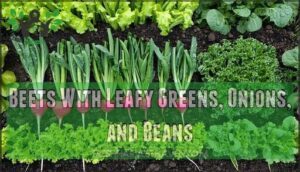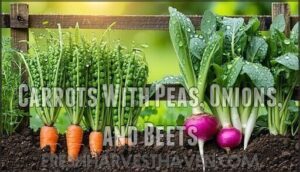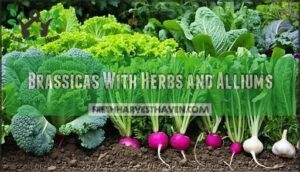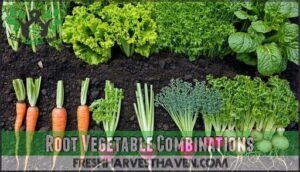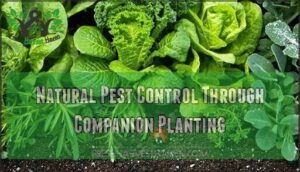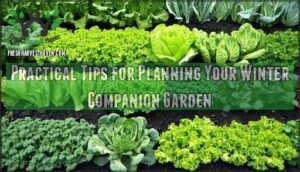This site is supported by our readers. We may earn a commission, at no cost to you, if you purchase through links.
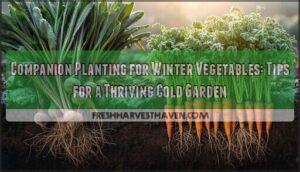
Clever combinations yield healthier, heartier vegetables when the days are shortest. Tuck beets next to onions and watch both thrive, or let peas cozy up to carrots for extra sweetness come harvest time.
These pairings do more than fill your basket—they create an underground network where roots share resources, pests stay in check, and the cold loses its bite.
Table Of Contents
- Key Takeaways
- How Companion Planting Benefits Winter Gardens
- Best Companion Plant Pairings for Winter Vegetables
- Natural Pest Control Through Companion Planting
- Maximizing Growth and Health in Cold Weather
- Practical Tips for Planning Your Winter Companion Garden
- Frequently Asked Questions (FAQs)
- Conclusion
Key Takeaways
- Companion planting in winter helps your vegetables stay healthier by pairing plants that support each other’s growth and naturally deter pests.
- Pairings like beets and onions, or carrots and peas, boost soil health, improve yield, and reduce the need for chemicals.
- Strong-smelling herbs, flowers, and alliums can act as natural barriers to keep bugs away, while also attracting helpful insects for extra pest control.
- Planning your winter garden with smart plant combinations, good layout, and seasonal care tips leads to a more productive and resilient patch, even in the cold.
How Companion Planting Benefits Winter Gardens
Companion planting brings out the best in your winter garden, even when the weather turns cold. It helps your vegetables grow stronger, healthier, and more productive.
Companion planting helps winter gardens thrive, giving vegetables the strength and health to flourish even as the cold sets in
Here are a few ways companion planting can make a real difference.
Boosting Vegetable Yields Naturally
Watching your winter garden burst with healthy veggies starts with pairing the right plants together, giving each one a natural boost. Companion planting creates synergy, letting you:
- Get the most out of garden yield with smart winter crop density
- Use organic yield methods for steady harvests
- Improve soil health naturally
- Practice sustainable garden techniques—no extra chemicals needed.
Reducing Pest and Disease Pressure
You want fewer pests nibbling on your winter crops? Pairing up the right companion plants is your secret weapon. Trap cropping draws pests away; alliums like garlic keep them guessing. Aromatic repellents, like sage or thyme, send bugs packing. Plus, mixed rows make life tough for plant diseases—think of your garden as an ever-changing puzzle pests can’t crack. One of the main benefits is efficient space use.
| Strategy | Example Plants |
|---|---|
| Trap cropping | Radishes, kale |
| Allium suppression | Garlic, onions |
| Aromatic repellents | Sage, thyme |
| Habitat manipulation | Alyssum, nasturtium |
Improving Soil Fertility and Structure
Healthy soil makes for healthy plants, right? Companion planting helps you there—beans and peas boost Nitrogen Fixation, while root crops like carrots improve Soil Aeration.
Mixing root depths and plant types boosts Microbial Diversity and Enzyme Activity, leading to richer Organic Matter. Intercropping methods, such as planting radishes with lettuce, can increase production in a small area.
That means better soil nutrients for your winter veggies, a stronger garden, and much less need for extra fertilization.
Attracting Beneficial Insects
If you’ve ever noticed ladybugs on your lettuce or bees hovering over winter blooms, that’s your garden putting out the welcome mat for its best tiny helpers. Companion planting boosts beneficial insects by weaving pollinator-friendly plants and insectary strips through your winter vegetables.
Provide habitat creation, water sources, and reduce pesticides—suddenly, nature’s own pest control works for you, quietly and effectively.
Best Companion Plant Pairings for Winter Vegetables
If you want your cold garden to thrive, choosing the right plant partners is key. Some veggies just get along better, helping each other stay strong through the winter.
Here’s how you can pair up your winter crops for healthier growth.
Beets With Leafy Greens, Onions, and Beans
Curious about boosting your winter harvest? Try pairing beets with leafy greens and onions for a masterclass in soil moisture retention and pest deterrence. Here’s how companion planting shapes your garden:
- Beets and spinach improve moisture and growth.
- Onions shield beets from pests.
- Together, they encourage compatible growth.
- Avoid beans—they stunt beet root development.
- Lettuce thrives beside beets, benefiting from loosened soil.
Carrots With Peas, Onions, and Beets
To get the most from your winter carrots, try pairing them with peas, onions, and beets.
Peas provide nitrogen fixation, boosting root health and growth. Onions act as natural pest repellents, warding off carrot flies. Good companion spacing with beets aids soil drainage and keeps roots from competing.
Thoughtful companion planting lets your carrots thrive in chilly months.
Brassicas With Herbs and Alliums
Right alongside your winter brassicas, smart companion planting can work wonders for pest control and flavor. Herbs like dill lure in predatory insects, while alliums such as garlic and onions fend off cabbage moths with natural sulfur compounds. You’ll see:
- Fewer pests nibbling leaves
- Improved crop flavor
- Less disease pressure
- Happier, healthier brassicas all winter long
Root Vegetable Combinations
Think intensive interplanting is tricky? Not with root vegetables. Carrots, beets, and turnips lend themselves to simultaneous sowing, thriving as long as you space them right and match their moisture needs.
Onions protect beets and carrots from pests, while a patch of flax adds natural defense for carrots. Smart companion planting makes your winter vegetable gardening far more rewarding.
Natural Pest Control Through Companion Planting
Keeping pests in check during winter starts with a bit of strategy and the right plant neighbors. Some pairings do more than just help your crops grow—they send pests packing, too.
Here’s how certain companion plants can make your cold-season garden a lot less welcoming for pesky visitors.
Using Strong-Smelling Plants to Deter Pests
Ever noticed how some plants seem to keep the bugs at bay just by the way they smell? That’s the magic of Scent-Based Deterrents.
Strong-scented herbs and alliums act as aromatic barriers, doubling as natural insecticides.
Fragrant herbs like rosemary or chives create an automatic fence—simple, reliable pest deterrents you can weave right into your garden as natural pest control.
Repelling Aphids, Beetles, and Cabbage Moths
Picture your garden as a cozy fortress—each plant plays defense. Aphid-repelling plants like onions and dill keep sap-suckers away. For beetle deterrents, try mixing in bush beans.
Brassicas? Use moth confusion with trap cropping, tucking decoys like radish nearby. These natural pesticides provide gentle, ongoing pest control, turning your patch into a haven from aphids, cabbage moths, and beetles.
Marigolds and Nasturtiums as Pest Barriers
When you want to add another layer of protection to your garden’s defense squad, marigolds and nasturtiums are about as dependable as a good friend showing up just when you need them.
With Marigold pest control and nasturtium insect lure, barrier planting design truly shines. Trap cropping efficacy gets a real boost, and these companion flower benefits are key to natural pest control methods.
Attracting Pest Predators to The Garden
Once your flower allies are in play, it’s time to roll out the welcome mat for nature’s own bug bouncers—those helpful predators that keep the real troublemakers in check. Attract hoverflies and support ladybug habitats by leaving a few “messy” corners.
Lacewing benefits and predatory wasps come alive with a splash of diversity, while birdhouses help round out natural pest control.
Maximizing Growth and Health in Cold Weather
Keeping your winter garden thriving takes a few key strategies you can add right now. There are simple ways to protect plants, keep soil healthy, and stretch your harvest when the weather turns cold.
Here’s what to focus on as you plan your cold-weather garden.
Providing Shade and Shelter With Plant Pairings
Tucked in beside the right neighbors, your winter veggies can cozy up to taller plants that shield them from biting winds and harsh sunlight. Tall plant pairings like kale and sunflowers offer excellent windbreak strategies, while broad-leaved shelter plant selections create microclimates.
This shade provider tactic is a cornerstone of winter gardening strategies—reducing frost risk and amplifying companion planting benefits for cool weather crops.
Enhancing Soil Nutrients With Legumes
Just as a sturdy shelter protects plants, legumes—like peas, clover, and vetch—work quietly below the surface through nitrogen fixation. These legume types act as nature’s fertilizer, boosting soil health and organic matter.
With cover cropping, you’re not just plugging a nutritional gap; you’re weaving organic nutrients into your winter beds, giving vegetables exactly what they crave for steady cold-weather growth.
Mulching and Soil Preparation Tips
Before your shovel ever hits the dirt, giving your soil a cozy blanket of mulch sets the stage for strong, healthy winter veggies. Winter mulching locks in moisture, shields roots, and helps with drainage improvement.
Blend in organic matter and natural fertilizer as soil amendments. Testing pH balance? That’s smart—ideal conditions support vigorous growth, weaving in key organic gardening practices right from the start.
Extending The Harvest Season
Even as colder days start to settle in, there are plenty of clever tricks to help your winter garden keep producing long after you’d expect. Try these:
- Tuck coolseason crops under cold frames or row covers to buffer them from frost.
- Practice succession planting for steady harvests.
- Choose overwintering crops and winter companion plants to stretch your garden’s productivity and extend those growing seasons.
Practical Tips for Planning Your Winter Companion Garden
Ready to plan your winter garden so it thrives, not just survives? Here’s what to keep in mind as you choose companions and map out your space.
These basics will set you up for a garden that grows strong through the cold months.
Choosing Suitable Plant Combinations
Think of winter companion plants as neighbors who effortlessly share resources. Good vegetable plant pairings—like carrots and onions or beets and leafy greens—offer space efficiency and nutrient synergy thanks to different root depths and growth compatibility.
With smart winter pairings, you’re setting up cool-season crop combinations that thrive together, a real illustration of practical companion planting strategies for planting brassicas and beyond.
Garden Layout and Planting Strategies
Getting your winter vegetables off to a strong start begins with a thoughtful garden layout—think of it like setting the stage for a well-rehearsed play where every plant knows its cue.
Consider:
- Boost yields with smart Spatial Arrangement and Vertical Gardening.
- Use Sunlight Management for cool-season crop combinations.
- Incorporate Crop Rotation and Succession Planting to keep winter companion plants thriving.
Seasonal Planting and Care Advice
When winter’s approaching, knowing when and how to plant your veggies can make all the difference between a flourishing bed and a frosty flop. Tuck in cold-hardy varieties early, mulch generously for frost protection, and stick to a sensible watering schedule.
Winter fertilization keeps roots strong, while smart seasonal planting advice ensures your winter companion plants thrive and your growing season stretches longer.
Using Charts, Guides, and Online Tools
Why guess your way through companion planting when a handy chart, guide, or garden app can turn confusion into confidence? Explore chart interpretation for quick combinations, digital planning tools to map out cold season plants, and guide selection for trusted advice.
Look for app features that track soil temps and join community forums—there’s a planting guide for every cold weather gardening question.
Frequently Asked Questions (FAQs)
How close should companion plants be spaced?
It’s funny—plants don’t read garden books, yet sometimes act like they do. Ideal proximity means avoiding root competition but allowing for nutrient sharing, sunlight access, and growth impact.
Companion planting strategies help cold season plants make the most of garden planning.
Can companion planting work in container gardens?
Absolutely, companion planting works in container gardens. Mind your container size and soil limitations, pick plant compatibility wisely, and improve space.
Cool-season crops thrive together. Adjust watering needs for your vegetable gardening success—these gardening tips keep your container garden healthier.
Are there companion flowers for winter vegetables?
Pairing cold-hardy blooms like calendula or pansies with winter crops means more than just pretty faces—these companion flowers help by repelling pests, boosting beneficial insects, and attracting pollinators, all while offering ornamental and edible flower benefits.
What mistakes should be avoided in companion planting?
Ignoring plant needs or overcrowding plants leads to competition, not cooperation. Poor planning or incorrect timing can wreck pest control and growth.
Don’t fall into a monoculture mindset; companion planting—key in organic gardening—boosts fall vegetables with simple gardening tips.
How does companion planting affect crop rotation plans?
Some folks treat crop rotation charts like rigid dance steps. But real gardening thrives on improvisation.
Companion planting weaves Rotation Integration, Nutrient Cycling, and Pest Management together, letting your vegetable garden boost Soil Health and promote smarter Succession Planting.
Conclusion
What if winter’s coldest days were the start of something lively, not the end? With companion planting for winter vegetables, your garden becomes a close-knit community, quietly working together beneath the frost.
Each pairing plays its part—sharing warmth, deterring pests, and lending a little flavor where it’s needed. You shape that quiet hustle, choosing who grows side by side.
When spring returns, you’ll see that every careful match brought your winter plot to vibrant life.

